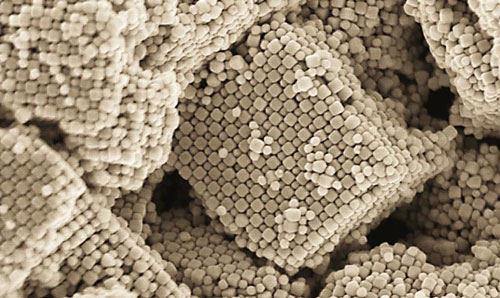DNA (deoxyribonucleic acid) is being exploited in ways that would have seemed unimaginable to me when I was in high school. Earlier today (June 3, 2015), I ran a piece about DNA and data storage as imagined in an art/science project (DNA (deoxyribonucleic acid), music, and data storage) and now I have this work from the US Department of Energy’s (DOE) Brookhaven National Laboratory, from a June 1, 2015 news item on Nanowerk,
You’re probably familiar with the role of DNA as the blueprint for making every protein on the planet and passing genetic information from one generation to the next. But researchers at Brookhaven Lab’s Center for Functional Nanomaterials have shown that the twisted ladder molecule made of complementary matching strands can also perform a number of decidedly non-biological construction jobs: serving as a scaffold and programmable “glue” for linking up nanoparticles. This work has resulted in a variety of nanoparticle assemblies, including composite structures with switchable phases whose optical, magnetic, or other properties might be put to use in dynamic energy-harvesting or responsive optical materials. Three recent studies showcase different strategies for using synthetic strands of this versatile building material to link and arrange different types of nanoparticles in predictable ways.
The researchers have provided an image of the DNA building blocks,

Controlling the self-assembly of nanoparticles into superlattices is an important approach to build functional materials. The Brookhaven team used nanosized building blocks—cubes or octahedrons—decorated with DNA tethers to coordinate the assembly of spherical nanoparticles coated with complementary DNA strands.
A June 1, 2015 article (which originated the news item) in DOE Pulse Number 440 goes on to highlight three recent DNA papers published by researchers at Brookhaven National Laboratory,
The first [leads to a news release], published in Nature Communications, describes how scientists used the shape of nanoscale building blocks decorated with single strands of DNA to orchestrate the arrangement of spheres decorated with complementary strands (where bases on the two strands pair up according to the rules of DNA binding, A to T, G to C). For example, nano-cubes coated with DNA tethers on all six sides formed regular arrays of cubes surrounded by six nano-spheres. The attractive force of the DNA “glue” keeps these two dissimilar objects from self-separating to give scientists a reliable way to assemble composite materials in which the synergistic properties of different types of nanoparticles might be put to use.
In another study [leads to a news release], published in Nature Nanotechnology, the team used ropelike configurations of the DNA double helix to form a rigid geometrical framework, and added dangling pieces of single-stranded DNA to glue nanoparticles in place on the vertices of the scaffold. Controlling the code of the dangling strands and adding complementary strands to the nanoparticles gives scientists precision control over particle placement. These arrays of nanoparticles with predictable geometric configurations are somewhat analogous to molecules made of atoms, and can even be linked end-to-end to form polymer-like chains, or arrayed as flat sheets. Using this approach, the scientists can potentially orchestrate the arrangements of different types of nanoparticles to design materials that regulate energy flow, rotate light, or deliver biomolecules.
“We may be able to design materials that mimic nature’s machinery to harvest solar energy, or manipulate light for telecommunications applications, or design novel catalysts for speeding up a variety of chemical reactions,” said Oleg Gang, the Brookhaven physicist who leads this work on DNA-mediated nano-assembly.
Perhaps most exciting is a study [leads to a news release] published in Nature Materials in which the scientists added “reprogramming” strands of DNA after assembly to rearrange and change the phase of nanoparticle arrays. This is a change at the nanoscale that in some ways resembles an atomic phase change—like the shift in the atomic crystal lattice of carbon that transforms graphite into diamond—potentially producing a material with completely new properties from the same already assembled nanoparticle array. Inputting different types of attractive and repulsive reprogramming DNA strands, scientists could selectively trigger the transformation to the different resulting structures.
“The ability to dynamically switch the phase of an entire superlattice array will allow the creation of reprogrammable and switchable materials wherein multiple, different functions can be activated on demand,” Gang said.
Here are links to and citation for all three papers,
Superlattices assembled through shape-induced directional binding by Fang Lu, Kevin G. Yager, Yugang Zhang, Huolin Xin, & Oleg Gang. Nature Communications 6, Article number: 6912 doi:10.1038/ncomms7912 Published 23 April 2015
Prescribed nanoparticle cluster architectures and low-dimensional arrays built using octahedral DNA origami frames by Ye Tian, Tong Wang, Wenyan Liu, Huolin L. Xin, Huilin Li, Yonggang Ke, William M. Shih, & Oleg Gang. Nature Nanotechnology (2015) doi:10.1038/nnano.2015.105 Published online 25 May 2015
Selective transformations between nanoparticle superlattices via the reprogramming of DNA-mediated interactions by Yugang Zhang, Suchetan Pal, Babji Srinivasan, Thi Vo, Sanat Kumar & Oleg Gang. Nature Materials (2015) doi:10.1038/nmat4296 Published online 25 May 2015
The first study is open access, the second is behind a paywall but there is a free preview via ReadCube Acces, and the third is behind a paywall.